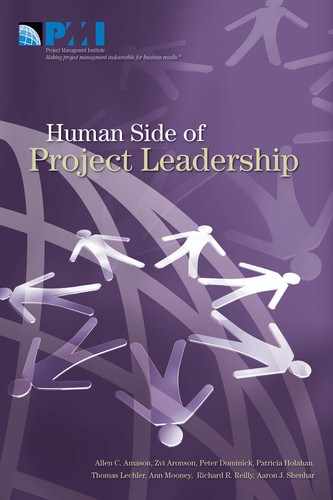CHAPTER 8
Spirit-Building Activities
Vision
Vision refers to a commonly held attitude regarding the direction, goals and mission of the project team (Cannon-Bower et al. 1995). It helps illuminate the core values and principles that will guide the team in the future. It gives a sense of direction. It evokes meaning and a deep commitment. It serves as glue to bind the team together. Effective visions are grounded in core values about which team members feel passionate (Whetten and Cameron 2005). For the purpose of this work, we define project vision as a statement that expresses the value of the product and its competitive advantage. It articulates the state of affairs once the project is competed (Shenhar 2004). We concentrate on vision, since by focusing attention on a meaningful vision the leader operates on the emotional and spiritual resources of the project, rather than on its physical resources.
Values
Behavioral characteristics that differentiate one leadership pattern from another may be explained through assessing differences in the leader’s value and belief systems. Transformational leaders report value systems that are distinguishable from other types of leaders. Transformational leadership behavior is linked with values that encourage personal and professional development as well as common good (Krishnan 2001; Sarros and Santora 2001). Participants in projects bring various talents, orientations, values, allegiances, and aspirations to the project setting. Leaders are called on to manage the interaction among subcultures that collide at the project setting. We center our attention on leaders’ values, since the success of creating the right micro-culture, a component of spirit, for the right project may be attributed to the leaders’ abilities to infuse their own values into their interactions with project members, so new values are internalized, and new behaviors are learned (Goffee, and Jones 1998; Saffold 1988; Schein 1996).
Team Events and Rituals
Team events are social activities in which the team engages, that may or may not relate to the work itself. These events glue the team together as one unit and create a bond among its members. They may be formally or semiformally organized, regularly scheduled activities that engage people. Team events may involve information-sharing meetings, joint training workshops and off-site team-building activities (Pettigrew, Trice, and Beyer 1992). They may also include social activities such as parties, field trips, or other joint team outings.
Managers sponsoring such events send a clear message regarding the extent that teamwork is important and intensive interaction is encouraged. For example, a well-established schedule of formal meetings for sharing information, exchanging and developing ideas, expressing disagreement, and managing conflict helps ensure that diverse voices and ideas are heard and discussed in open forums so that a shared understanding emerges among participants.
Team activities should be accompanied by specific project and team rituals. Rituals may include the manner in which meetings are opened, team members’ gestures to one another, or the way in which people turn or call each other. Such rituals may help build the right atmosphere, create a common attitude in the team member’s minds, and foster cohesion.
Symbols
Symbols are visible artifacts that are unique to the project and symbolize the team spirit and specific goal. The study of artifacts has been central to scholarly writings on culture. (Detert et al. 2000; Schein 1992). This interest stems from the notion that cultural artifacts are observable signs that can be used to decipher the unseen, complex, and often interactive elements of cultures, such as beliefs, values, and assumptions. In turn, cultural artifacts, including rituals and symbols, are expected to exert powerful influences on shaping values, beliefs, and desirable behaviors among participants.
Symbols may include layout and design of the work environment, the displayed documentation, dress code, and other concrete objects that signify the priorities and desired behaviors of project members (Schein 1996).
